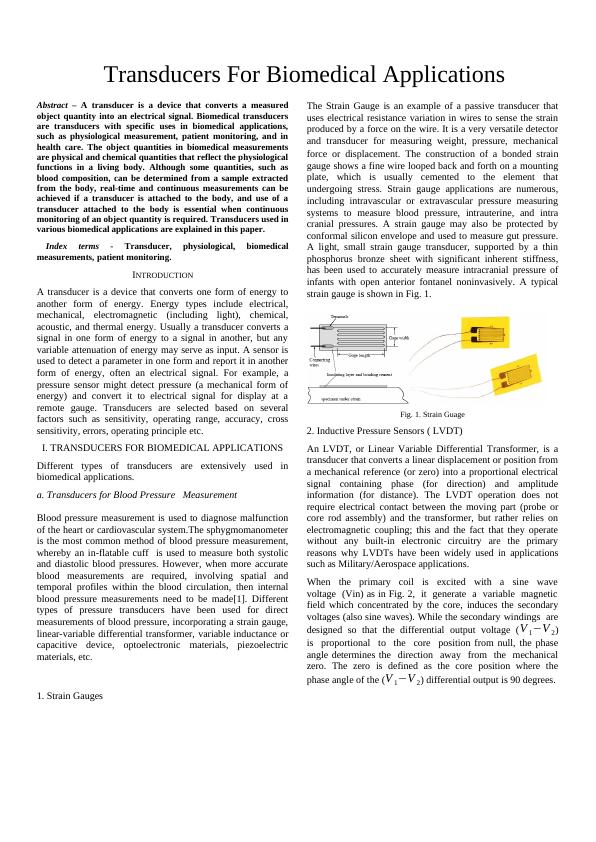(PDF) Physical Sensors for Biomedical Applications
Added on 2021-06-07
3 Pages1613 Words112 Views
Transducers For Biomedical ApplicationsAbstract – A transducer is a device that converts a measuredobject quantity into an electrical signal. Biomedical transducersare transducers with specific uses in biomedical applications,such as physiological measurement, patient monitoring, and inhealth care. The object quantities in biomedical measurementsare physical and chemical quantities that reflect the physiologicalfunctions in a living body. Although some quantities, such asblood composition, can be determined from a sample extractedfrom the body, real-time and continuous measurements can beachieved if a transducer is attached to the body, and use of atransducer attached to the body is essential when continuousmonitoring of an object quantity is required. Transducers used invarious biomedical applications are explained in this paper.Index terms - Transducer, physiological, biomedicalmeasurements,patient monitoring.INTRODUCTIONA transducer is a device that converts one form of energy toanother form of energy. Energy types include electrical,mechanical, electromagnetic (including light), chemical,acoustic, and thermal energy. Usually a transducer converts asignal in one form of energy to a signal in another, but anyvariable attenuation of energy may serve as input. A sensor isused to detect a parameter in one form and report it in anotherform of energy, often an electrical signal. For example, apressure sensor might detect pressure (a mechanical form ofenergy) and convert it to electrical signal for display at aremote gauge. Transducers are selected based on severalfactors such as sensitivity, operating range, accuracy, crosssensitivity, errors, operating principle etc.I. TRANSDUCERS FOR BIOMEDICAL APPLICATIONSDifferent types of transducers are extensively used inbiomedical applications.a. Transducers for Blood Pressure MeasurementBlood pressure measurement is used to diagnose malfunctionof the heart or cardiovascular system.The sphygmomanometeris the most common method of blood pressure measurement,whereby an in-flatable cuff is used to measure both systolicand diastolic blood pressures. However, when more accurateblood measurements are required, involving spatial andtemporal profiles within the blood circulation, then internalblood pressure measurements need to be made[1]. Differenttypes of pressure transducers have been used for directmeasurements of blood pressure, incorporating a strain gauge,linear-variable differential transformer, variable inductance orcapacitive device, optoelectronic materials, piezoelectricmaterials, etc.1. Strain GaugesThe Strain Gauge is an example of a passive transducer thatuses electrical resistance variation in wires to sense the strainproduced by a force on the wire. It is a very versatile detectorand transducer for measuring weight, pressure, mechanicalforce or displacement.The construction of a bonded straingauge shows a fine wire looped back and forth on a mountingplate, which is usually cemented to the element thatundergoing stress.Strain gauge applications are numerous,including intravascular or extravascular pressure measuringsystems to measure blood pressure, intrauterine, and intracranial pressures. A strain gauge may also be protected byconformal silicon envelope and used to measure gut pressure.A light, small strain gauge transducer, supported by a thinphosphorus bronze sheet with significant inherent stiffness,has been used to accurately measure intracranial pressure ofinfants with open anterior fontanel noninvasively. A typicalstrain gauge is shown in Fig. 1.Fig. 1. Strain Guage2. Inductive Pressure Sensors ( LVDT)An LVDT, or Linear Variable Differential Transformer, is atransducer that converts a linear displacement or position froma mechanical reference (or zero) into a proportional electricalsignal containing phase (for direction) and amplitudeinformation (for distance). The LVDT operation does notrequire electrical contact between the moving part (probe orcore rod assembly) and the transformer, but rather relies onelectromagnetic coupling; this and the fact that they operatewithout any built-in electronic circuitry are the primaryreasons why LVDTs have been widely used in applicationssuch as Military/Aerospace applications.When the primary coil is excited with a sine wavevoltage (Vin) as in Fig. 2, it generate a variable magneticfield which concentrated by the core, induces the secondaryvoltages (also sine waves). While the secondary windings aredesigned so that the differential output voltage (V1−V2)is proportional to the core position from null, the phaseangle determines the direction away from the mechanicalzero. The zero is defined as the core position where thephase angle of the (V1−V2) differential output is 90 degrees.

End of preview
Want to access all the pages? Upload your documents or become a member.
Related Documents
instrumentation and control systemlg...
|3
|1522
|86
(Solved) Types of transducer - Doclg...
|14
|3294
|102
Report on Sensorslg...
|7
|1890
|167
Advanced Measurement Systems and Data Analysis | Assignmentlg...
|11
|3014
|47
Instrumentation Assignment: Sensors, Signal Conditioning, Control Systemslg...
|5
|2184
|296
Equipment for Improving Measurements and Product Qualitylg...
|12
|2437
|14
